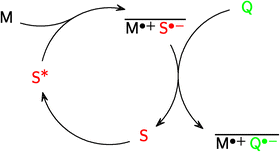Photoinduced electron transfer sensitization investigated by chemically induced dynamic nuclear polarizatioin (CIDNP)
Abstract
The key step of photoinduced electron transfer sensitization (sensitizer, S; donor substrate, M; quencher, Q) is the transformation of a primarily formed auxiliary radical ion pair  into the desired radical ion pair
into the desired radical ion pair  . The systems chosen exhibit striking CIDNP effects, which can only be explained by that pair substitution. An inversion of all polarization phases occurs when the quencher diethylfumarate is added to the two-component system
. The systems chosen exhibit striking CIDNP effects, which can only be explained by that pair substitution. An inversion of all polarization phases occurs when the quencher diethylfumarate is added to the two-component system


 Please wait while we load your content...
Please wait while we load your content...